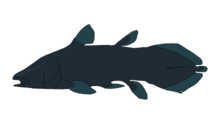Trachymetopon
| Trachymetopon | |
|---|---|

| |
| Trachymetopon liassicum | |
| Scientific classification | |
| Domain: | Eukaryota |
| Kingdom: | Animalia |
| Phylum: | Chordata |
| Clade: | Sarcopterygii |
| Class: | Actinistia |
| Order: | Coelacanthiformes |
| Family: | †Mawsoniidae |
| Genus: | †Trachymetopon Hennig, 1951 |
| Species | |
|
Trachymetopon liasicum Hennig, 1951 | |
Trachymetopon is an extinct genus of prehistoric coelacanth from the Jurassic of Europe. Fossils have been found in the Early Jurassic Posidonia Shale of Germany the Middle Jurassic Marnes de Dives of France, and probably the Late Jurassic Kimmeridge Clay of England.[1][2] Only one species has been named, Trachymetopon liassicum, described by Henning in 1951 from an almost complete specimen found in the Lower Toarcian of Ohmden in Baden-Württemberg.[3] Another specimen is known from the same site, and two older specimens come from the Sinemurian of Holzmaden.[4] The holotype of this species is 1.6 metres (5 ft 3 in) in length.[4] A giant specimen of an undetermined species of Trachymetopon found at the Middle Jurassic (Late Callovian) Falaises des Vaches Noires of Normandy. This specimen, composed of a 53 cm long palatoquadrate, belongs to an individual 4 metres (13 ft) in length.[5] A basisphenoid found in a museum in Switzerland that likely originates from the same locaity probably belonged to an individual around 5 m (16 ft) long, making Trachymetopon the largest of all coelacanths alongside Mawsonia.[1] A study published in 2015 revealed that this coelacanth belongs to the Mawsoniidae.[4] Trachymetopon is one of the few known mawsoniids to have been exclusively marine (with an indeterminate form from the Triassic of France), while most of the other members of the group have lived in fresh and brackish waters.[6]
Phylogeny[edit]

A phylogenetic analysis of the mawsoniids published in 2020 found a polytomy grouping together Trachymetopon and the Cretaceous genera “Lualabaea”, Axelrodichthys, and Mawsonia. The genus “Lualabaea” could be congeneric with Axelrodichthys.[7]
| |||||||||||||||||||||||||||||||||||||||||||||||||
See also[edit]
References[edit]
- ^ a b Cavin, Lionel; Piuz, André; Ferrante, Christophe; Guinot, Guillaume (2021-06-03). "Giant Mesozoic coelacanths (Osteichthyes, Actinistia) reveal high body size disparity decoupled from taxic diversity". Scientific Reports. 11 (1): 11812. Bibcode:2021NatSR..1111812C. doi:10.1038/s41598-021-90962-5. ISSN 2045-2322. PMC 8175595. PMID 34083600.
- ^ Toriño, Pablo; Gausden, Shane F.; Etches, Steve; Rankin, Kathryn; Marshall, John E. A.; Gostling, Neil J. (2022). "An enigmatic large mawsoniid coelacanth (Sarcopterygii, Actinistia) from the Upper Jurassic Kimmeridge Clay Formation of England". Journal of Vertebrate Paleontology. 42 (1). e2125813. Bibcode:2022JVPal..42E5813T. doi:10.1080/02724634.2022.2125813. S2CID 253141244.
- ^ Hennig, E. (1951). Trachymetopon liassicum, Ald., ein Reisen-Crossopterygier aus Schwäbischem Ober-Lias. Neues Jahrbuch für Geologie und Paläontologie, Abhandlungen, Stuttgart, 94, 67-79.
- ^ a b c Dutel, H.; Herbin, M.; Clément, G. (2015). "First Occurrence of a Mawsoniid Coelacanth in the Early Jurassic of Europe". Journal of Vertebrate Paleontology. 35 (3): e929581. Bibcode:2015JVPal..35E9581D. doi:10.1080/02724634.2014.929581. S2CID 140557693.
- ^ Dutel, H.; Pennetier, E.; Pennetier, G. (2014). "A Giant Marine Coelacanth from the Jurassic of Normandy, France". Journal of Vertebrate Paleontology. 34 (5): 1239–1242. Bibcode:2014JVPal..34.1239D. doi:10.1080/02724634.2014.838176. S2CID 130632357.
- ^ Deesri, U.; Cavin, L.; Amiot, R.; Bardet, N.; Buffetaut, E.; Cuny, G.; Giner, S.; Martin, J.E.; Suan, G. (2018). "A mawsoniid coelacanth (Sarcopterygii: Actinistia) from the Rhaetian (Upper Triassic) of the Peygros quarry, Le Thoronet (Var, southeastern France)". Geological Magazine. 155 (1): 187–192. Bibcode:2018GeoM..155..187D. doi:10.1017/S0016756817000619. S2CID 134867757.
- ^ Cavin, L.; Buffetaut, E.; Dutour, Y.; Garcia, G.; Le Loeuff, J.; Méchin, A.; Méchin, P.; Tong, H.; Tortosa, T.; Turini, E.; Valentin, X. (2020). "The last known freshwater coelacanths: New Late Cretaceous mawsoniids remains (Osteichthyes: Actinistia) from Southern France". PLOS ONE. 15 (6): e0234183. Bibcode:2020PLoSO..1534183C. doi:10.1371/journal.pone.0234183. PMC 7274394. PMID 32502171.





